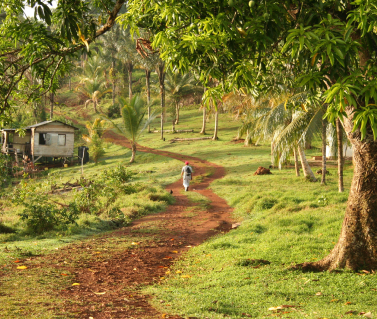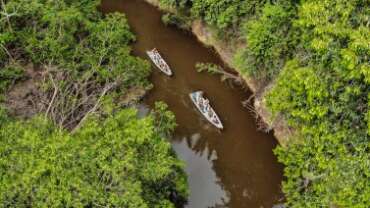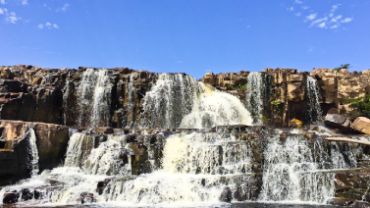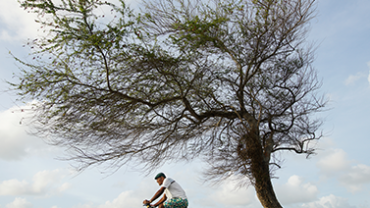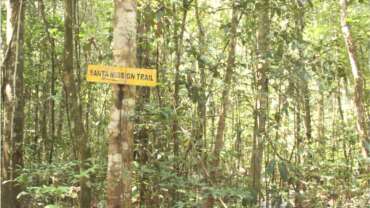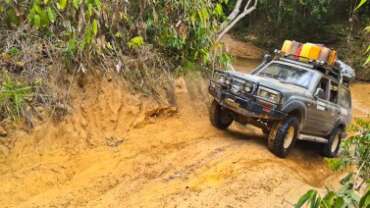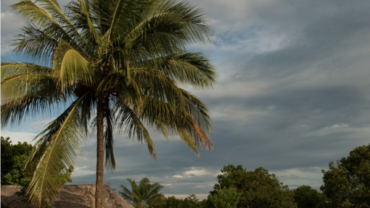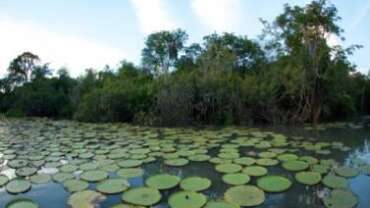Protected Areas of Guyana
The ancient forests, eroded riversides, expanses of grasslands and mountains make a fascinating playground for botanists, zoologists and nature lovers travelling to Guyana. There are a number of protected areas in the country that house a variety of flora and fauna to entice visitors. Guyana is one of the few countries where travellers can have first row seats to nature’s treasures.
Iwokrama Rainforest Reserve
The Iwokrama Protected region covers 3,710 square kilometres (almost a million acres) – an area so massive that it is hard to imagine its complete span. It is often referred to as the ‘Green Heart of Guyana’ for being the largest continuous woodland area and home to the best of nature – exotic wildlife, numerous bird species and a diversity of plant life. Many of the ‘giants’ of Guyana can be found here, along with an abundance of marine life thanks to the Essequibo, which runs along the forest, livening up the ecosystem. This was once the land of Makushis, where they hunted, fished and gathered food. History lovers will be happy to see scenes from their lives, depicted in petroglyphs around the region and hear stories from the source, as many Makushis from neighbouring Fairview Village work in Iwokrama. Little disturbed stretches of this virgin forest can be explored from different eco-lodges in the forest. Iwokrama’s biodiversity makes it one of the best wildlife destinations of South America.
THINGS TO SEE AND DO
Indian House Island Boat Tour
An early morning tour is highly recommended to circumnavigate this small island. You will hear the jungle come alive with the sounds of red howler monkeys and scores of birds. The area around the island is also a nesting site for giant river turtles during the dry season.
Fairview Village
Fairview is the only Indigenous community located inside the vicinity of the Iwokrama forest. It was once the hub of cattle rearing and balata trading. The village is home to approximately 200 families of Makushi Indigenous Peoples who are happy to take visitors around the village and to their butterfly farm.
Kurupukari Falls, Toro Falls, Petroglyphs & Stanley Lake
Use Fairview Village as the base to explore a number of sights close by.
– Only a ten-minute walk or a short boat ride from Fairview lies the Kurupukari Waterfall. On the same trip, one can also see the 6000-year-old petroglyphs, which were made by the current resident’s ancestors. The petroglyphs are essentially line drawings chiselled on rock face that depict daily life. There are some other sights close by too.
– Stanley Lake is surrounded by dense forests, and is home to howler monkeys, jaguars and other iconic animals of the Iwokrama forest. The waters are soothing to the eyes as well as offer re wards of spotting giant river otters, giant river turtles and arapaimas.
– It is said that the cool blue waters of the Toro Falls once sustained the ancient Makushi people when they first came to Iwokrama. The 30-foot falls lie south of Fairview Village and offer an idyllic location to take a is dip into after hiking the nature trails.
Turtle Mountain & Camp
The 950 foot high mountain gets its name from a lake of the same name that lies at the base. A boat ride to the trailhead and an invigorating 90-minute hike rewards with expansive, cliff-side views of swathes of green all around. Expect unique bird life, small mammals, and pristine rainforest along the hike.
Atta Rainforest Lodge & Canopy Walkway
The comfortable, well-appointed, and conveniently located Atta Rainforest Lodge make it a regular stopover on the Linden-Lethem Road. The highlight of this property is the canopy walkway. The 154-meter state-of-the-art canopy walk offers a unique experience of being eye level with the birds. A series of suspension bridges and decks up to 30 meters off of the ground allow an alternative view of the treetops and their fascinating occupants.
Iwokrama Mountain Trail
Avid trekkers will love this 12.5 kilometre rigorous and oftentimes steep hike set in the wilderness dotted with creeks, waterfalls and thick vegetation. At an elevation of 3000 feet atop the mountain, trekkers will experience the cooling breeze and stellar views. This complete jungle immersion allows close proximity to wild animals and birds and is ideal for any nature lover.
Sport Fishing
The Essequibo, Burro Burro and Siparuni Rivers that run through the Iwokrama Forest Reserve are hot spots for sport fishing enthusiasts. The peacock bass, piraiba, lukanani and banana fish are the most popular in the region, though visitors need to adhere to catch and release fly fishing.
Wildlife Spotting & Birding from Iwokrama River Lodge
The field station found at the Iwokrama River Lodge is a good base to hire naturalist guides and go on walking trails or boat rides to spot capybaras, arapaima, anacondas, sloth bears, harpy eagles, giant river otters, even a jaguar if you’re lucky. They even have their own resident black caiman, Sankar, hanging around to greet you as you approach the lodge. The nocturnal trips to spot the ‘creatures of the night’ are even more exciting in the thick forests when the sounds of the jungle look more menacing, and caiman eyes shine like diamonds in the water. Iwokrama has also been identified as one of the best birding destinations of the world. 471 bird species that have been recorded in the Iwokrama forest. Birders come with long checklists, often with antbirds, woodcreepers, trogons, parrots and macaws on top of the lists.
Kaieteur National Park
The coffee coloured Potaro River thunders down 741 feet into the beautiful and majestic Kaieteur Falls. Kaieteur is one of the highest and most powerful single drop waterfalls in the world – nearly four times higher than Niagara Falls and twice as high as Victoria Falls. It is part of the lush, pristine rainforests of Kaieteur National Park that spans 627 square kilometres around the iconic waterfall. Of the hundreds of bird species found here, the Guianan Cock-of-the-rock, White Collared Swifts, and macaws are often seen in the lush surrounds. Other fascinating flora and fauna include tank bromeliads and the golden frog. The brilliant morpho butterfly can also be spotted in the Kaieteur gorge. The combination of the magnificent waterfall, wildlife, and remote and uncrowded National Park make this one of the top places to visit in Guyana
THINGS TO SEE AND DO
View Points & Overnight Camping
There are three main viewpoints to witness the majestic beauty of the Kaieteur Falls. The hiking trail affords stops and photo opportunities at Johnson, Boy Scout, and Rainbow viewpoints, named after the visible rainbows you can often see at this spot. Though the trail only takes 20 minutes to walk, the entire tour typically lasts two hours, which gives you ample time to spend at each viewpoint. Two other points, Break and Lookout, are closed for general visitors and require special permission from the Protected Areas Commission to visit.
Interpretive Centre
A small museum with a picture gallery and signage about the history of Kaieteur Falls can be found alongside the meeting pavilion close to the airstrip. This is a good spot to get familiar with the exotic wildlife that populates the area and facts and history about Kaieteur National Park. There is also a small souvenir shop with local crafts that are available for sale.
Johnson View Nature Trail
Located just off of the first viewpoint, the Johnson View Nature Trail is a short trail where your guides may help you to spot the vibrant cock-of-the-rock. This is a famous spot for them to roost (rest or sleep). If you are lucky you can also spot the tiny Kaieteur golden rocket frog hiding in one of the nearby tank bromeliads.
Kanuku Mountains Protected Area
As one of the wildest and remotest regions of Guyana, the Kanuku Mountains amp up the adventure quotient on several accounts. The forest is home to 60% of all bird species found in Guyana and over 150 mammals, offering a single stop for your wildlife curiosity if you are limited on time. Arresting sights are guaranteed in this vibrant protected land include Harpy Eagles, jaguars, armadillos, giant river otters, giant anteaters and arapaima. It’s no wonder the Wapishanas named the region ‘Kanuku’, which simply translates to ‘rich forest.’ Kanuku is one of the last remaining intact Amazonian habitats of the world and one of the most beautiful places in South America.
THINGS TO SEE AND DO
Wildlife Spotting & Birding
Staggering statistics of 2,300 species of animals and more than 6,000 plants makes this one of the most exciting places in Guyana for nature enthusiasts. The Kanuku’s cool climate makes it the ideal home for 60% of bird species and 70% of the mammal species of the country. The forest offers hundreds of nature trails which are best explored with local guides who can point you to Harpy Eagle roosting sites, help you identify plant and bird species, and share their personal tales of adventure with you.
Moco Moco Mountain
One of the most accessible activities in the Kanuku is hiking Moco Moco Mountain. Starting from the namesake village at the base, the Moco Moco hike is partially made of a natural trail interspersed with 999 concrete steps. With 50 shades of green to keep you company, the hike up can be done in a few hours. Parts of the route are steep, but it is largely manageable by those who are reasonably fit. On top, there is a man-made swimming spot to cool off in, and short walking trails that lead to different look outs. There are also longer multi-day trekking routes. The views of the vast stretch of dense green bush is soothing after the effort.
Active Adventures
Sky Valley Tours, Guyana Truly Wild and Wilderness Explorers offer multi-day tours in the Kanukus. This includes trekking, day hikes, wildlife spotting and birding. In addition to the wilderness camping you’ll experience during a trek, there is a more comfortable albeit rustic opion to overnight at Mapari Creek Camp with Guyana Truly Wild.
Village Life
Home to Wapishana group of Indigenous Peoples, the villages in Kanuku are a reflection of local life in the wilderness. Unassuming local culture, deeply rich in traditions and sense of community offer an immersive learning experience.
Konashen Community-Owned Conservation Area
Located in the far south of the country, Konashen is Guyana’s first community-owned protected. The Wai Wai Indigenous People are the keepers of this land. Regarded as Guyana’s most traditional tribe, they worked hard to have their ancestral lands recognised as a conservation area and now have the title to the 2300 square mile protected area. They did this for strictly one reason – the forests of Konashen have been intact for millennia, and their dense forests are a sanctuary for wildlife. The reward for travelling to the deep south comes in the form of spotting giant armadillos, harlequin toads and tapirs – three globally threatened species. Apart from these, one is never too far from labbas, jaguars, giant anteaters and at least 400 species of birds. It is a virtual paradise for nature lovers looking for an offbeat wildlife vacation and intrepid travellers who enjoy remote wilderness areas that have had little impact from the outside world.
THINGS TO SEE AND DO
Wildlife Spotting & Birding
The tall evergreen highland forests are home to192 creatures, including tapir, giant anteater, Harpy Eagles, all six of Guyana’s monkeys, anaconda, black caiman, giant river otters, and the rare blue poison arrow frog. Jaguars have been spotted many times during outfitted visits. Amongst the 170 species of birds, the Screaming Pihas, trogons, parakeets, manakins and antbirds offer birding enthusiasts ample reason to visit. The nature trails are raw and untouched – a delightful proposition for both real nature enthusiasts.
Village Tour
The isolation and low-density population of the Wai Wais makes Konashen even more intriguing. The locals have maintained their traditional lifestyle, including hunting with bows and arrows, blow pipes and curare tipped darts. They are happy to share their culture and daily practices with visitors partial to sustainable tourism. The agro practices, handicrafts and cultural traditions are enriching for anyone who visits. This village is not as established for tourism as is Surama or Rewa, but this makes the experience that much more immersive.
Active Adventures
From experiencing timeless culture, canoeing the Kassikaityu River and hiking through pristine rainforest to fishing in oxbow lakes, seeking out ancient petroglyphs and visiting the Great Falls of the Essequibo, there is a lifetime of adventure experiences to be had in Konashen. The best way to visit is through one of the few tour operators that are permitted to visit, which include Bushmasters and Rupununi Trails.
Community Conservation Areas
Indigenous Peoples worldwide have been living in harmony with nature for millennia. Collectively, they manage or have tenure rights over a quarter of the world’s land surface, yet they have responsibility for 80% of its biodiversity. In Guyana, the percentage is much higher. Indigenous Peoples primarily reside in the interior, comprising more than 90% of the country’s land mass. The value of the biodiversity, ethnobotany, and heritage of the hinterland is priceless. These rich natural and cultural ecosystems have attracted explorers for hundreds of years. peaks. Many of the lands managed by Guyana’s Indigenous Peoples are voluntarily protected by local communities. These communities have made an effort to protect fragile wildlife habitats, contain human influence, and maintain ancient traditional practices to conserve these areas, all while educating visitors on their critical role in helping to protect the lungs of the planet.
Things To Do And See
Konashen Community-Owned Conservation Area
Located deep in the South Rupununi, Konashen Community-Owned Conservation Area (COCA) is the set amid the headwaters of the Essequibo River and the Wassarai, Yahore, Komoa and Kaiawakua Mountains. Spread over 625,000 hectares, this region is considered one of the last pristine rainforests with unmatched biodiversity. The conservation area is managed by the local Wai Wai community, who have inhabited this land for generations. The Masakenari community of the Wai Wais who live here, have a deep spiritual, cultural and social connection with the land. They practice shifting cultivation, clearing the forest for agro practices, and keeping soil rejuvenation at the core to maintain the fragile tropical rainforest ecosystem. The tall highland forests and clean, unpolluted waters of the region are home to a remarkable diversity of fish. There is a healthy population of giant river otters, capybaras, and a few species of caiman. Large mammals such as jaguars, tapirs, bush dogs, giant anteaters, and saki monkeys are still common. Over 400 species of birds have been reported from the region, and the diversity of reptiles and amphibians are similarly rich. As the first legally protected community-owned conservation area in Guyana, Konashen has paved the way for many more.
Yupukari
The village of Yupukari is a conservation hotspot. Here the locals have protected the rainforest adjacent to the Rupununi River and partnered with researchers, scientists and conservation groups to build upon their knowledge and capacity for conservation work. The Wapishana and Makushi Indigenous Peoples have taken on the responsibility of overseeing village concerns, development and conservation work. It is a great example of community-led conservation. Set near the near the Kanuku Mountain Range and within the Rupununi-Ireng ecological corridor that links the Amazon and Essequibo Rivers, this is one of the most biodiverse regions of Guyana and is home to over 70% of the mammal population and 53% of avian species of the entire country. This means, that chances of spotting some of the most fascinating wildlife are extremely high here. The village is a base for Caiman House Field Station, a conservation centre for the black caimans and the yellow-spotted river turtles. Caiman House also doubles up as accommodation for travellers, who can experience Yupukari and the surrounding areas with local guides.
Surama Rainforest
Surama Village Eco-lodge lies at the edge of the rainforest amid the golden savannahs of the North Rupununi at the foothills of the Pakaraima Range of Mountains. This is one of Guyana’s best conserved, high biodiversity hotspots. The largely primary rainforest along the Burro Burro River that skirts the village is protected by the local community of Makushi People. Surama Eco-lodge was established in 2004 with a vision to “develop, own and manage a community-based ecotourism business by constructively using the natural resources and traditional culture in a socially appropriate manner.” After 15 years, it is an integral part of Guyana’s nature and wildlife travel circuit. The community-led enterprise unites the community to protect their natural resources and use them to generate sustainable livelihoods. Conservation awareness and natural resource management practices at the household level are made through environmental awareness outreach programs. This results in each household making a conscious effort to reduce exploitation of the forests for food, fuel and building materials, ensuring that the integrity of the ecosystem is preserved.
Rewa River Watershed & Apoteri Tribal Waters
The Rewa River is a tributary of the Rupununi River and is found just upstream of the confluence of the Rupununi and Essequibo Rivers. The headwaters of the Rewa offer travellers a unique opportunity to explore pristine habitat where it is said that the wildlife is not afraid of humans. Few people travel all the way here by river as the journey is difficult. Most travellers opt to fly to Annai or Apoteri and take a shorter river journey from there. Rewa Eco-lodge and Guyana Truly Wild are the only operators that offer the four-week expedition covering more than 200 river miles. Set at the mouth of the river, Rewa Eco-lodge is owned and operated by its namesake indigenous community who protects the watershed. This results in some of the best and most sustainable catch and release sport fishing in Guyana. Spotting giant river otters, black and spectacled caimans and river turtles is relatively easy. There are also opportunities to spot tapirs, jaguars, ocelots, capybaras, giant armadillos, peccaries and seven different species of monkeys.
Located at the confluence of the Rupununi and Essequibo Rivers, Apoteri village is just downstream of Rewa Village. The community conserves its tribal waters along the Essequibo from Yakatu Lagoon to King George Falls for catch and release sport fishing. During the years the fishery has been protected, the size and number of fish have increased significantly. King William Adventures and community members have documented 40 species. Both host visitors for fishing, village tours, birdwatching and more.
The South Rupununi Conservation Society and Karasabai
Formed in 2000, the South Rupununi Conservation Society comprises community members from six villages helps who banded together to protect the region’s flora and fauna. This includes the red siskin, a rare bird that was greatly endangered by the cage bird trade. Since the surprising discovery, the society has been working hard to determine the size of the population, its behaviour and habitat for conservation purposes. The village of Karasabai in the North Rupununi has undertaken similar efforts at on a smaller scale to protect the endangered Sun Parakeet. Recently a giant anteater monitoring project has been launched by the South Rupunununi Conservation Society at Wichabai Ranch and Guest Houses.
Shell Beach Protected Area
The 90-mile stretch of pristine beaches on the northern shores of the country is one of the best conservation hotspots and nesting sites for turtles. March to August is the period when four of the eight sea turtle species of the world, come to lay eggs here. The Green, Hawksbill, Leatherback and the Olive Ridley species have made this a regular nesting spot, offering a one-of-a-kind hot spot for wildlife enthusiasts. The nine sections of Shell Beach are passionately protected and can be visited only with permission from the Protected Areas Commission. The leading turtle biologist, Dr. Peter Pritchard, started conservation efforts in1960s. Later, Audley James, an ex-turtle hunter joined hands to fortify efforts. Due in part to its highly remote location and the fact that few people visit, the species continue to thrive here.
THINGS TO DO
Turtle Hatching
Watching turtle hatching and releasing into the sea requires permission from the Protected Areas Commission and camping at the beach with modest facilities. Serious wildlife lovers typically opt to sign up with tour operators to see the entire process. Female turtles dig an egg chamber and fill it with around 100 eggs before covering it with sand. The hatchlings emerge around 45 to 70 days later, making their way to the water, furiously moving their flippers. Experts say that between 15 and 40 years later, many of these same hatchlings will return to Shell Beach to continue the cycle. This is a great adventurous and educational trip as a weekend getaway from Georgetown.
Wildlife Spotting And Bird Watching
More than 250 species of birds and 30 of mammals have been identified in the Shell Beach Protected Area. Look out for the ibis, herons, egrets, flamingoes, antbirds, toucans, macaws, Harpy Eagles and more. Amongst mammals, sightings of jaguars, manatees, capuchin monkeys, tapirs, sloths and others are commonly spotted. With a large array of wild habitants, this is one of the most unique wildlife getaways in the country.
Village Life
Adjacent to Shell Beach Protected Area, Warapoka is the closest indigenous community that caters to travellers . One of the prime fishing spots in the region, the members of the community recently embarked on establishing a community-owned and operated eco-lodge for travellers. Sustainable catch and release sport fishing is one of the key activities visitors to the village can enjoy. The much sought-after tarpon, lou lou and bashar fish species are just a few of the more exotic fish that populate these waters. There are also several Harpy Eagle nests nearby, increasing the likelihood that one will be nesting when you visit.



